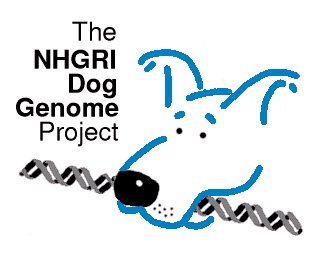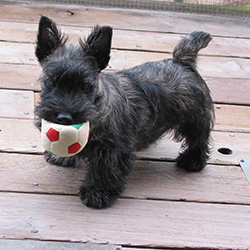Labradors, Terriers, and Boxers — Oh My! IRP Researchers Delve Into Doggy DNA

Despite their massive physical differences, these two dogs are indeed members of the same species. Through the Dog Genome Project, NIH scientists are investigating how such closely related individuals can be so glaringly different.
For over a decade, my family shared our home with a short, fat beagle named Kayla Sue. She had big floppy ears, a tail as straight as an exclamation point, and a coat of fur that was a patchwork of white, brown, and black splotches. Her love of chasing small animals was matched only by her enthusiasm for eating, napping, and belly rubs. One of my best friends growing up, on the other hand, had a mean-spirited Dachshund named Rocky who would not let anyone outside his family touch his long, brown, sausage-shaped body. Meanwhile, one of my brother’s close childhood friends had two humongous, overly-friendly, black-and-brown German shepherds that would immediately bowl you over when you walked through the front door.
It doesn’t take a particularly sharp observer to notice that, despite being the same species, the more than 300 breeds of dog have remarkably different physical and behavioral traits. But what remains less clear even today are the specific biological roots that produce these widely varying attributes. And, perhaps more importantly, scientists seek to understand how learning about that immense diversity might help us improve the health of our canine companions — and ourselves.
The National Human Genome Research Institute’s Dog Genome Project, led by IRP Distinguished Investigator Elaine Ostrander, Ph.D., aims to use genome sequencing to answer those questions and many more. On February 21, Heidi Parker, Ph.D., a staff scientist in Dr. Ostrander’s research group, gave a small taste of the insights emerging from this scientific endeavor. Her talk, titled “How to Build a Dog in 2,392,715,236 Simple Steps,” was part of the Biowulf seminar series, which highlights research that utilizes the NIH’s cutting-edge supercomputer, Biowulf. Thirteen different users from the Ostrander lab alone have used nearly 15 million CPU hours on Biowulf over the past five years to analyze data from this project. Even their smaller datasets can take a week to run on the supercomputer. If they used any more of Biowulf’s computing power, we might have to start calling it “Bio-woof” instead.

Dr. Parker and her colleagues use Biowulf to sift through the entire genome sequences of over 700 individual dogs, including 516 purebreds, to identify the genes behind breed-defining traits and assess the genetic relatedness of different breeds. In one experiment she discussed, she examined 150,000 single-base-pair variations in the DNA of 11 hairless dogs and scrutinized the entire genomes of one hairless dog and 89 non-hairless dogs in order to narrow the source of that trait to a gene called SGK3. In another study, she used an algorithm she had developed to reveal the ancestry of mixed-breed dogs. Interestingly, her algorithm also allowed her to identify 30 purebred dogs that were actually not purebreds at all. In addition, by examining sets of genes that are inherited together (called ‘haplotypes’), Parker’s group developed a fairly accurate method for estimating how long ago different types of mixed-breed dogs were produced through crossing purebreds. The technique pegged the most recent cross of a bullmastiff and a bulldog as happening in 1880, for example, while historical sources place the event somewhere in the mid-1800’s.
Dr. Parker also discussed intriguing work being done by her colleagues in the Ostrander lab. Postdoctoral fellow Jocelyn Plassais, Ph.D., is using whole-genome sequencing to pinpoint genes related to a variety of breed-specific traits from ear size and shape to weight to aggressive behaviors and even lifespan. What’s more, many of the genes he is finding have never been associated with those characteristics before. Meanwhile, another postdoctoral fellow, Jacquelyn Evans, Ph.D., is investigating the genetic basis of a cancer called histiocytic sarcoma in Bernese mountain dogs, a breed that has a much higher risk for the disease than others of its species.

Studies like Dr. Evans’ reveal why scientists in the Intramural program at the National Institutes of Health, an organization dedicated to improving human health, would put so much effort and resources towards sequencing the genomes of dogs. Man’s best friend suffers from many of the same conditions that we do — cancer, heart disease, diabetes, epilepsy — but these illnesses often have a clearer inherited component in dogs than in humans, which is why certain breeds are particularly prone to certain health problems. By identifying the genes that produce such diseases in dogs, researchers could potentially shed light on the genetic and biological mechanisms that underlie the same illnesses in humans. To further this pursuit, Dr. Ostrander launched a global consortium called the Dog 10K Genome Project in 2015 that aims to collect and sequence the genomes of 10,000 dogs.
So go on and give your dog a nice belly rub. Your canine comrade deserves the reward for helping scientists learn more about how to keep you healthy.
Subscribe to our weekly newsletter to stay up-to-date on the latest developments in the NIH Intramural Research Program.
Related Blog Posts
This page was last updated on Tuesday, January 30, 2024
